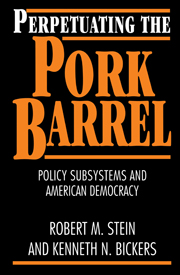Book contents
- Frontmatter
- Contents
- Tables and figures
- Acknowledgments
- PART I
- PART II
- PART III
- PART IV
- APPENDIXES
- 1 Descriptive data base of domestic assistance programs
- 2 Geographical data base of domestic assistance awards
- 3 Programs by agency and policy type
- 4 Departments and their distributive policy agencies
- 5 Federal agencies in four cabinet departments: Budgetary changes proposed by the Reagan administration for FY 1983
- 6 Financial assistance programs by public law bundle
- 7 PACs whose parent interest groups testified in hearings, grouped by public law and PAC coalition
- 8 Roll call votes in the U.S. House of Representatives on nine public laws
- 9 Probit results for House roll call votes on nine public laws
- 10 Concepts and measures
- Notes
- Bibliography
- Index
1 - Descriptive data base of domestic assistance programs
Published online by Cambridge University Press: 05 June 2012
- Frontmatter
- Contents
- Tables and figures
- Acknowledgments
- PART I
- PART II
- PART III
- PART IV
- APPENDIXES
- 1 Descriptive data base of domestic assistance programs
- 2 Geographical data base of domestic assistance awards
- 3 Programs by agency and policy type
- 4 Departments and their distributive policy agencies
- 5 Federal agencies in four cabinet departments: Budgetary changes proposed by the Reagan administration for FY 1983
- 6 Financial assistance programs by public law bundle
- 7 PACs whose parent interest groups testified in hearings, grouped by public law and PAC coalition
- 8 Roll call votes in the U.S. House of Representatives on nine public laws
- 9 Probit results for House roll call votes on nine public laws
- 10 Concepts and measures
- Notes
- Bibliography
- Index
Summary
The underlying source for the data base on U.S. domestic assistance programs that we have constructed is the Catalog of Federal Domestic Assistance (CFDA). In this appendix we discuss the data file that contains descriptive information on programs for each year from 1971 through 1990.
The data file derived from the CFDA contains no geographic detail nor is it a record of the specific awards made by federal agencies. Instead it describes the types of recipients that are eligible for assistance, the form of the assistance provided, the amount of money that the agency is authorized to spend on assistance awards, policy areas served by the program, and information about the history of the program.
The catalog was first published in 1965 by the Office of Economic Opportunity. From the outset, its purpose was to serve potential applicants and recipients of federal programs as a guide in applying for federal assistance. In its early years, the catalog underwent considerable evolution in coverage, content, and programmatic detail, making year-to-year comparisons across programs virtually impossible. By 1971, the catalog was being published by the Bureau of the Budget and had matured into essentially the form that it continues to take today (in the early 1980s it was shifted to the General Services Administration). Several points should be noted about the catalog and, by extension, the data file that is based on it.
First, the operational definition of a domestic assistance program used in the catalog provides a reasonable approximation to the formal definition of a program offered in Chapter 1.
- Type
- Chapter
- Information
- Perpetuating the Pork BarrelPolicy Subsystems and American Democracy, pp. 153 - 156Publisher: Cambridge University PressPrint publication year: 1995



